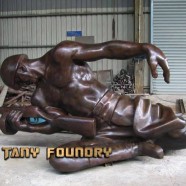3 Tips to Achieve High Quality Polished Sculpture
Tany Foundry has been working hard to test different approaches to achieve high quality polished finishing on bronze and stainless steel cast sculptures. We’d like to introduce three proven effective tips to artists on how we polish on sculptures. Tip 1: Chasing and finishing bronze casting very carefully. The quality of chasing is closely related to the final quality on polished finishing. Therefore, every imperfection has to be fixed; every pinhole has to be filled. The surface before polishing has to be very smooth and consistent. Good quality casting is the foundation for nice polishing. One thing worth noting is that unlike stainless steel fabrication , it is difficult to achieve mirror polishing finishing on stainless steel casting. Tip 2: Choosing polishing tools carefully. We employ multiple step polishing approach. For the preliminary polishing process, we use rough polishing wheel then proceed to use finer polishing material. Use while polishing compound first, when use green compound. Above: polishing compound: green and white. Above: Polishing wheel Tips 3: Control the temperature of the casting when polishing. Polishing process will generate large amount of heat, which should be avoided as it will burn the surface of the metal and lower the polishing quality. It is a good idea to use fan or water cooling system to coll down the surface of metal when polishing. Feel free to contact us if you have any technical question of your own project. We offer free technical consultancy to...
Read MoreTips on Making Great Wax Mould for Bronze Casting (2)
This article explores how to make wax mould with irritation approach and demonstrate a case study using this technique. Below is a case of using irritation technique to make wax mould. Irritation approach is suitable for producing small scale sculpture with height around 20 inches. Step 1: pour molten wax into silicone mold, which is usually with a plaster jacket. Spin and shake the silicone mould slowly and steadily to make the molten wax flow freely onto all silicone mould surface. Step2: place the silicone mould still for while and wait wax to cool a little bit and irritate the liquid wax. The wax left in the silicone mould will solidify and form the wax mould. The thickness of current wax mould is very thin so you will repeat the process described above a couple of times to get the desired thickness. To make the thickness of wax mould consistent, it’s important to spin and shake the silicon mould a little bit so liquid wax can capture every details of the sculpture. Step 3: take off the wax mould from the silicone mould carefully to avoid any damage on wax occurring. Exam carefully the wax mould to check if there is any imperfection on the surface. Using a brush pen to dip molten wax onto those places where wax layer is very thin. The pro of the irritation approach is the partition line is not clear and easy to remove. Please let me know if you have any question or any comments by clicking here...
Read MoreIntroduction and Comparison of Bronze Casting
It’s helpful for sculptors to understand some commonly used bronze casting techniques. This can help artists to take technical factors into consideration when they are creating sculptures. I have seen some well sculpted work looks not so good because choosing a wrong technical approach. I plan to write a series articles on this topic . This series well be composed of several parts: a brief introduction on different casting techniques, their pros and cons, their suitable application and best practice, economical consideration on choosing one of them and some case study. I will try to make myself clear and easy to understand. Your comments would be the biggest support for me....
Read MoreTips on Making Great Wax Mould for Bronze Casting (1)
Lost wax technique is a suitable way for casting bronze sculpture which has complex structure and delicate texture. One of the benefit of lost wax technique is it provides sculptor an opportunity to refine or improve the wax work before bronze casting. The key factor of a successful bronze casting using this technique is to make excellent wax mould. The quality of wax mould affects the quality of bronze casting directly and there are two things to consider for making good wax mould. (1) Ways of forming wax mould (2) Using proper type of wax. Generally speaking, there are three basic approach of making wax mould. Compressing: put wax block into a compressing mold make from metal, rubber or plaster and just compress it to generate the desired shape. This is a quick way to make multiple copies of wax mould. Wax mould made in this way is usually of high quality, showing clear outline and details. Irrigation. It’s hard to use compressing way to form some shape such as human bust. There where irrigation way stands. Pour molten wax into a negative mould (usually silicone ) and keep it cool for a while until the wax wall forms and then let go the molten wax. By this, we can get a wax mould without seam. This technique is relatively hard to operate because you must be very sensitive to wax temperature. Brushing. For those sculpture with simple shape, brushing is a good way. It’s simple to operate. Use a brush to dip into molten wax and brush onto a negative mould to form positive wax mould. Make sure brushing all over around and the thickness of wax mould consistent. We will talk about the details about tips on making good wax moulds in the next few articles. (Owen...
Read More
